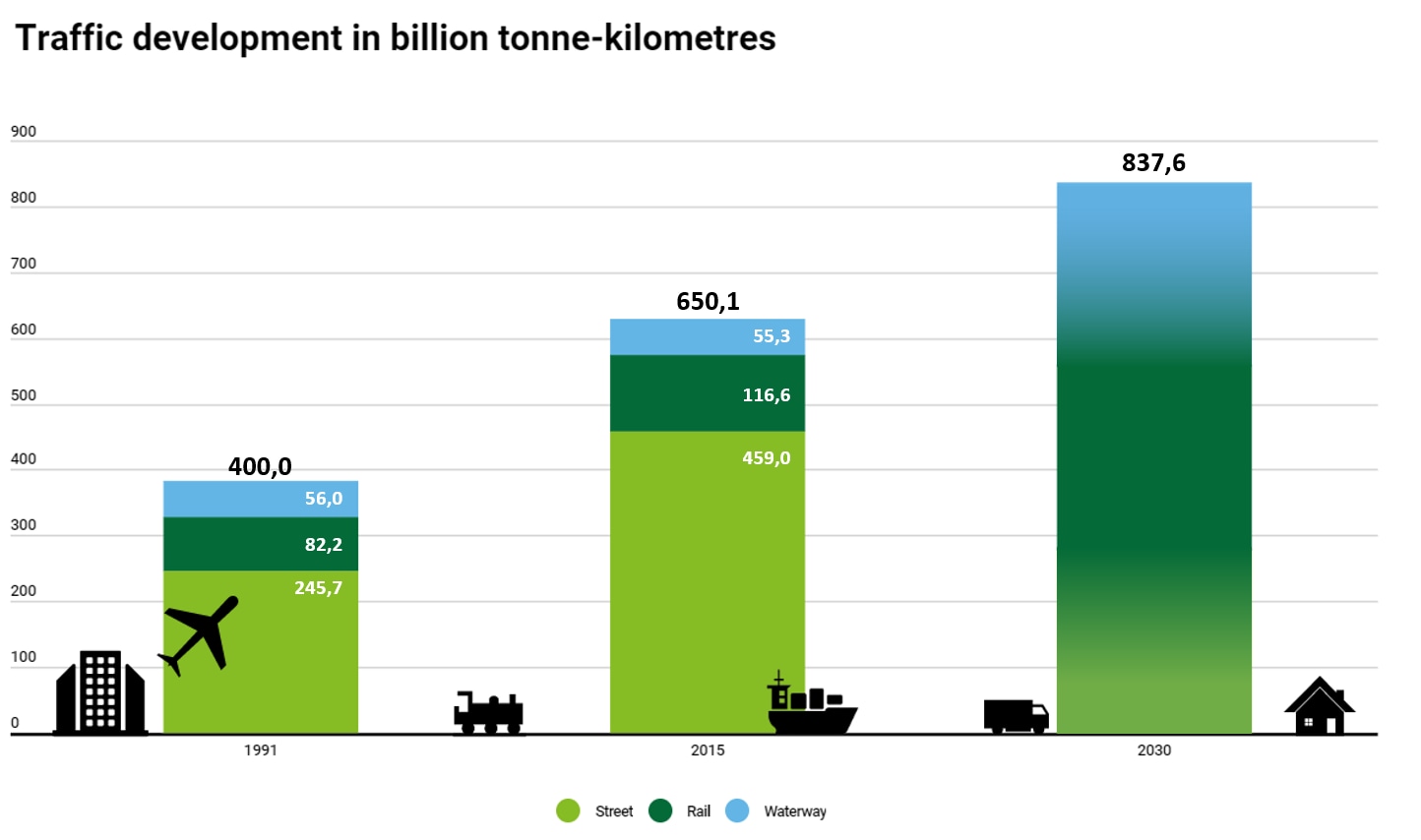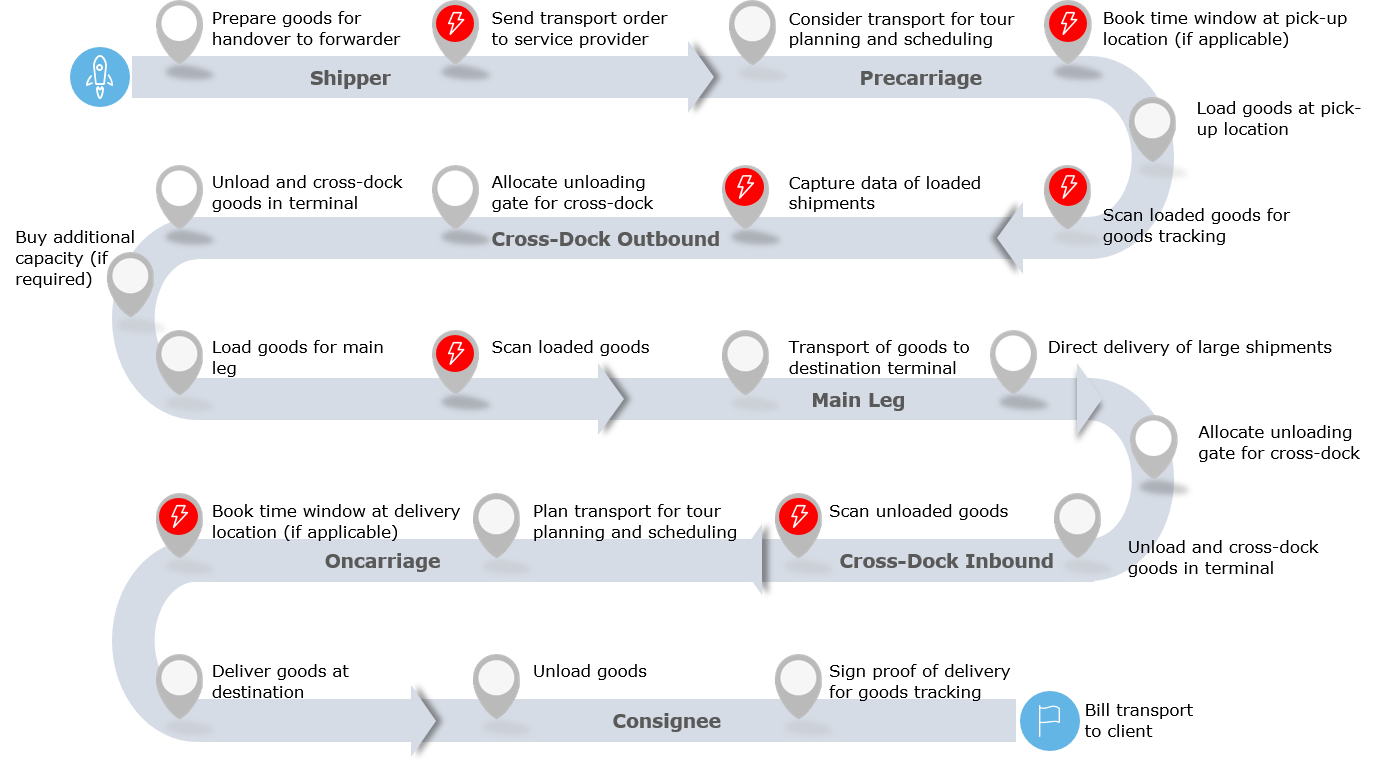Current situation and forecasts
Over the past decades, supply chains have become increasingly global and the growing demand for e-commerce has led to an increase in shipments and customer expectation. In parallel with increasingly demanding global requirements and customer demands, the logistics industry has to cope with enormous staff shortages in transport, fragmented markets, and low margins. It is therefore important to find solutions to optimize the logistics process in terms of efficiency, load capacity and planning, because only then will the industry be able to meet the enormous challenge of the coming years. Modern technologies such as IoT, Blockchain and the cloud play a major role in this topic, which is why this article takes a closer look at the logistics process in order to then present technology-driven and Deloitte proven solutions for the major challenges we identified.

Challenges within the logistics process
The following illustration shows an example of the process of a logistics network operator. Changing external factors, as well as increasing customer requirements pose the need for further development and expansion of the current process. With the pressure to become more and more efficient, this confronts the logistics industry with several challenges.

Receiving transport orders
Digitization in companies is advancing more and more. Even though processes are increasingly being carried out electronically, logistics service providers often receive their orders outside the transport systems - often still via analog channels. This increases the effort required on the part of logistics service providers to record shipment data.
Booking time windows
In order to optimize the yard planning, staff utilization and operational processes, an increasing number of clients is asking their logistics providers to book dedicated time windows to pick-up and deliver goods. The booking of the time windows usually needs to take place 24h before pick-up/delivery. The booking itself causes additional effort for the logistics providers and reduces efficiency. In addition to that, the flexibility to plan the pick-up/delivery tour is reduced which can negatively affect the utilization of the available loading capacity.
Scanning of goods
Customers are increasingly demanding reliable transparency on the status of shipments from their service providers. This requirement presents logistics companies with an enormous challenge. On the one hand, the recording of the conventional barcode by warehouse personnel is time-consuming and therefore inefficient. On the other hand, additional information, such as temperature or vibrations, must be transmitted to the customer more frequently. Current transport systems are often not suited to provide this type of information.
Capture data of loaded shipments
In the event that companies do not transmit their shipment data electronically, the data must be recorded by the service provider. This entails the risk of incorrect information being recorded, which is even increased by the existing shortage of skilled workers and outsourcing. In addition, shipments cannot be reloaded as long as the shipment data has not been recorded. In reality, this repeatedly leads to delays in operational processes.
How modern technologies help you cope with logistics challenges
What is IoT and what benefits do we get from it?
The Internet of Things (IoT) provides data which describe objects (“physical assets”, example: a good to be transported) distributed worldwide. Asset data can be available in real time and at low cost in a central location, enabling completely new use cases and business models. The objects can either collect or transmit data themselves via sensors (“active assets”, example: the navigation system of a truck) or they are not equipped with the necessary electronics (“passive assets”, example: a transport container). In the latter case, you need another device (“IoT Edge Device”) that determines the current values of the asset via sensors, preprocesses the data and transmits it.
IoT was only made possible by the general and inexpensive availability of three enablers:
- Universal and easy-to-use communication networks, some of them even free of contract (examples: NBIoT, LoRaWAN)
- Powerful and easy-to-integrate sensors and actuators, inspired by the maker scene
- Scalable cloud services for processing large amounts of data
In the logistics process of people and goods, IoT helps to track objects, but also to transfer current data of the transported assets. An IoT channel can also be used to remotely control elements of the transport process. This can save energy or avoid waiting times, for example.
What advantages do digital platforms and the cloud offer?
A digital platform combines software components on the basis of which digital services can be implemented quickly and reliably. Closely related to the platform is the agile software development and the DevOps paradigm, which ensure a good match between the functional characteristics of services and the needs of the users.
Digital platforms are often based on open source products and the microservices architectural approach. This allows them to adapt flexibly to changing load profiles, especially when operated in the cloud. This is a great advantage for logistics providers whose order situation is subject to considerable fluctuations throughout the year.
Why do we need the Blockchain?
The Blockchain - generally: Distributed Ledger Technology (DLT) - enables distributed and secure data storage without the persons or companies involved having to establish a relationship of trust explicitly and at great expense beforehand. The architecture and algorithms of the Blockchain ensure that there is consensus regarding the stored data and that it cannot be changed after it has been stored (“immutable memory”). These are important features for the use of the technology in the context of IoT and the logistics processes where typically a lot of parties are involved.
One example is the storage of measurement data acquired by an IoT edge device that describes the current state of a transported good (e.g. temperature). Storage in the Blockchain ensures that participants in the distribution process cannot subsequently change the data required, for instance to prove that the transport task has been properly fulfilled to their advantage. In this way legal certainty can be easily established on the basis of DLT.
How can these technologies improve the logistics process?
With the possibilities of IoT, a digital platform and the use of blockchain technology, the logistics process can be made considerably more efficient. Media breaks are avoided and the availability of current data in real time allows the process to be controlled to the benefit of all parties involved.
A digital platform avoids media breaks and enables collaboration
Digital platforms receive data from IoT channels, recognize patterns during processing and derive statements about the current state of the business process. They offer this aggregated information to other software systems involved in the logistics process via interfaces based on established Web standards such as Representational State Transfer (REST) and JavaScript Object Notation (JSON).
If these interfaces are equipped with secure options for authentication of the platform participants already in the design phase and their use is openly documented, media breaks can be easily avoided - the end of paper, fax and e-mail.
Equally important is that the platform can evolve into an ecosystem that leaves traditional supply chain patterns behind. Supply and demand can now be brought together quickly, e.g. through auctions. Process improvements become straightforward and universally available, such as real-time tracking of goods or connection to customer and government information systems. The necessary software solutions are offered by innovative start-ups on the logistics platform, creating a win-win situation: Innovative digital services are available to everyone and innovators receive a fair marketplace for their offers.
Easy identification and tracking of goods
Transport goods are in most cases passive physical assets, they are not IoT-capable themselves. However, they can be easily identified with the help of RFID markers. QR codes or Data Matrix codes are also suitable for this purpose, but compared to RFID, optical codes require a separate scan for each asset. Regardless of the hardware, a prerequisite for tracking the transported goods is their digital identity. It is best established when the transport order is generated. The creation of the identity is done by the service of the digital platform, which also manages the digital twins of the transport goods - without identity, no twin, without twin no tracking!
Digital twins can be related to each other - an example is the association of the twin of a transport good with the twin of the vehicle transporting the good. If the location of a vehicle is recorded regularly and the value is sent to its digital twin, the platform also updates the positions of all goods in the vehicle. Updates can be implemented so that the partners involved in the process are automatically notified. The transport process thus becomes transparent for all parties involved.
Further Readings
Shipping smarter – IoT opportunities in transport and logistics
· https://www2.deloitte.com/us/en/insights/focus/internet-of-things/iot-in-shipping-industry.html
Creating IoT ecosystems in transportation
Continuous interconnected supply chain – Using Blockchain & Internet of Things in supply chain traceability
Using smart sensors to drive supply chain innovation
Deloitte Reimagine Cold Chain – Track and manage temperature sensitive supply chains
· https://www.sapappcenter.com/apps/34509/reimagine-cold-chain#!overview